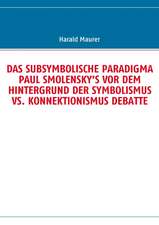Cognitive Science: Integrative Synchronization Mechanisms in Cognitive Neuroarchitectures of Modern Connectionism
Autor Harald Maureren Limba Engleză Hardback – 9 iul 2021
The book describes how elementary neuronal information is combined in perception and language, so it becomes clear how the brain processes this information to enable basic cognitive performance of the humans.
| Toate formatele și edițiile | Preț | Express |
|---|---|---|
| Paperback (1) | 543.86 lei 6-8 săpt. | |
| CRC Press – 15 apr 2022 | 543.86 lei 6-8 săpt. | |
| Hardback (1) | 1289.28 lei 6-8 săpt. | |
| CRC Press – 9 iul 2021 | 1289.28 lei 6-8 săpt. |
Preț: 1289.28 lei
Preț vechi: 1572.30 lei
-18% Nou
Puncte Express: 1934
Preț estimativ în valută:
246.71€ • 263.81$ • 205.70£
246.71€ • 263.81$ • 205.70£
Carte tipărită la comandă
Livrare economică 18 aprilie-02 mai
Preluare comenzi: 021 569.72.76
Specificații
ISBN-13: 9781138487086
ISBN-10: 1138487082
Pagini: 400
Ilustrații: 8 Illustrations, color; 45 Illustrations, black and white
Dimensiuni: 156 x 234 x 22 mm
Greutate: 0.93 kg
Ediția:1
Editura: CRC Press
Colecția CRC Press
ISBN-10: 1138487082
Pagini: 400
Ilustrații: 8 Illustrations, color; 45 Illustrations, black and white
Dimensiuni: 156 x 234 x 22 mm
Greutate: 0.93 kg
Ediția:1
Editura: CRC Press
Colecția CRC Press
Cuprins
Preface. Introduction: Theory of an Integrative Neurocognition. PART 1: FOUNDATIONS OF COGNITIVE SCIENCE. Cognitive Science: Integrative Theory of Cognition, Cognitivism and Computationalism. (General) Theory of (Nonlinear) Dynamical Systems and the Paradigm of Self-Organization. Theoretical Paradigms in Cognitive Science and in Theoretical Neurophilosophy. Integrative Synchronization Mechanisms and Models in the Cognitive Neurosciences. Mathematical, Physical and Neuronal Entropy Based Information Theory. PART 2: COGNITIVE NEUROARCHITECTURES IN NEUROINFORMATICS, IN COGNITIVE SCIENCE AND IN COMPUTATIONAL NEUROSCIENCE. Systematic Class of Classic Vector Based Architecture Typs. Systematic Class of Attractor Based Architecture Typs. Systematic Class of Oscillator Based Architecture Typs. Systematic Class of System Dynamic Based and Synapse Based Architecture Typs. Systematic Class of Information Based Architecture Typs. Epilogue: Discussion, Evaluation and Future Research. Bibliography. Index.
Notă biografică
Harald Maurer is a post-doctoral researcher at the Wilhelm-Schickard-Institute for Computer Science, in the Department of Mathematical Logic and Theory of Language (University of Tübingen). He is published in journals such as "Computational Cognitive Science" and "Journal for General Philosophy of Science," is a lecturer at the Universities of Tübingen, Heidelberg and Magdeburg since 2012. He has presented his research at the universities of Tübingen, Berlin, Magdeburg, Leipzig, Bochum, Stuttgart and at the Max-Planck-Institute for Brain Research in Frankfurt/Main.
Descriere
The book describes how elementary neuronal information is combined in perception and language, so it becomes clear how the brain processes this information to enable basic cognitive performance of the humans.


























